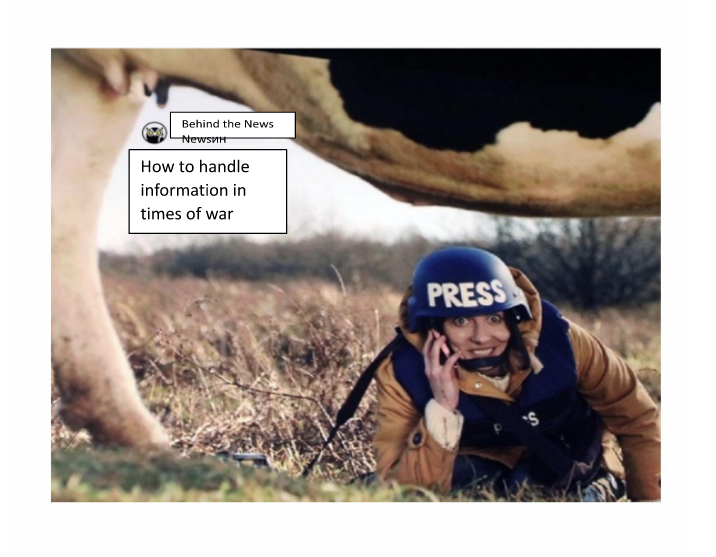How to handle information in times of war

Searching for “inside information”
It’s tempting to get insider information that you won’t find in mainstream media or official statements. You feel like you’re being initiated into a mysterious club for the elite. And for journalists, it’s an opportunity to be the first to publish sensational news and add an impressive number of visitors.
“They’ve gone crazy. As soon as it was clear what was going to happen and when, it became very scary; everyone began getting ready for the worst.”
“Something terrible has begun! Putin has been abandoned! They’re evacuating their families massively: Russian security forces are panicking! The regime is falling apart - we will win!”
At best, such headlines are classic clickbaits, at worst, Russian propaganda. We have deliberately chosen the most illustrative examples, but there are also less expressive ones.
To make the enemy’s fake news effective and for Ukrainians to fall for it, they dilute it with a pro-Ukrainian narrative. And they have it down to a T - - the classic 60x40 proportion, where the truth comes first. This formula has been around since the Second World War, and is attributed to the German Minister of Propaganda, Joseph Goebbels
There are a number of ways to identify such traps. First of all, you need to ask yourself a simple question: where did the author of the publication get this information? If it’s some anonymous source, or even someone “in the corridors” of the Verkhovna Rada, the President’s Office, or something similar, you should be very wary of such sources. In peacetime, politicians used such schemes to manipulate public opinion; today, Russian propagandists are usually behind such sources.
Here are some ways to recognize fake stories: grammatical errors not typical for a native speaker, vague knowledge of Ukrainian geography (such as the Troieshchyna metro station or the names of cities that have long been renamed), and the use of expressions atypical for the Ukrainian language. The most popular example is “розпові вчительке” (literally “tell the teacher” but with glaring spelling and grammar mistakes). This phrase has become a popular meme.
If every second headline in the news feed is sensational, you should close the website. Remember, even in times of war, sensational events don’t happen so often.
And perhaps most importantly, it’s very unusual for no name media, or even a telegram channel, to report on an important national event in Ukraine, and for the mainstream media to ignore it completely. Therefore, before you share something, ask yourself whether reputable publications, such as those on the IMI white list, have written about it (this list is not perfect, but at least it’s compiled according to a certain methodology, which you can read about and then you’ll understand why these media are listed).
And yet, it seems sometimes that these media outlets are slow in delivering the news. All telegram channels have already reported this piece of news, but there’s not a word about it in the news feeds of leading publications. This is usually due to the fact that the journalists of these media spend more time checking information.
So, take your time and check the information for accuracy. It’s better to be late and be second, third or fourth to publish this news than to spread disinformation and then, at best, write a refutation, and at worst, quietly delete the publication (don’t do this!).
Telegram channels
When the enemy attacks Ukrainian cities, we all want to know as much as possible - what, where, how it’s happening, from where the missile was launched, whether people were injured. However, emotional posts about hundreds of drones or missiles allegedly flying in the direction of your city don’t actually provide much information. But they do tend to stir up panic among residents, thus helping the enemy.
Here’s a revealing example: the mayor of Kremenchuk, Vitaliy Maletskyi. Since August, he’s had his own telegram channel, which he’s been actively promoting. Initially, he shared President Zelenskyy’s video messages and traditional official patriotic messages.
At the end of last year, he began actively commenting on the operations of the regional air defense, although his powers don’t cover the entire region. In fact, other authorities are responsible for the defense and security activities of the Poltava regional and Kremenchuk district military administrations. Consequently, this also applies to other mayors who aren’t heads of military administrations but who actively publish missile flight trajectories.
In fact, the information published by Vitaliy Maletskyi also turned out to be questionable. On October 11, repeated missile attacks were announced across Ukraine, and the mayor of Kremenchuk wrote: “It is reported that a cruise missile is flying in the direction of Kremenchuk”. The post didn’t say who reported it or whether the source was reliable.
Half an hour later, Maletskyi wrote about some cruise missiles, which had purposefully changed their flight direction in order to “mislead our air defense forces” and about a new missile launch from Belarus. No military or official source confirmed the cruise missile theory, nor did any other source confirm the attack from Belarus.
Subsequently, Vitaliy Maletskyi simply deleted the message about the missile attack from Belarus without actually retracting his statement. People aren’t likely to re-read Telegram messages, so if there’s no rebuttal, most readers won’t know about the edited or deleted posts. Meanwhile, the damage from “stirring up” the audience with disinformation has been done, while the publication of hype news increased the number of views on their personal channels.
Sometimes, official information can be distorted. For example, the Telegram channel “Trukha” helps the enemy by deliberately posting videos and photos of shelling, and by interpreting the events. The channel stirs up emotions among readers and publishes fake stories to increase its audience.
On October 18, the mayor of Ivano-Frankivsk, Ruslan Martsinkiv, reported something about an imminent attack and asked the citizens to take shelter. His message stated that “the enemy is bombing civilian energy infrastructure all across Ukraine. If possible, always keep a supply of drinking and technical water. And also be sure your phones are charged.”
But, “Trukha” interpreted it differently. The “imminent attack across Ukraine” turned into “an attack on Ivano-Frankivsk”: “Ivano-Frankivsk! Civilian infrastructure under attack!” This news was quickly picked up by the russian audience, who began celebrating the “strikes” on the city’s power system.
In such a simplistic way and with the help of fake news, info trash channels help the enemy intimidate Ukrainians and raise distrust of official sources.
Legalizing information
Russian propagandists consider that the most successful “news” is what has been re-printed by at least one bona fide independent media. This is how information is “legalized”. Some journalists tend to rely on the integrity of their colleagues, so they take their text without a second thought or additional verification. Of course, they don’t steal it, but cite it in good faith. This way, readers no longer see a dubious source from some Telegram channel or suspicious website, but a real media outlet. This increases audience trust.
Such an effect is difficult to achieve, so propagandists use “manual” websites as a last resort. There, they publish the “junk” they need, hoping that it will be picked up by some unwary journalist. Another way is to bribe non-controlled media to share them. Or they use any means possible to promote their trashy news website, thus gaining a large readership.
The most recent examples you’ve probably heard of are the heartbreaking posts on social media about poor orphans, wounded soldiers who have been forgotten and not even congratulated on their birthdays. There are plenty of examples. Ukrainians are very responsive and eager to like and share such posts. Tens if not hundreds of thousands of views. As soon as the job is done, the post is edited. Instead of the previous text, they give a description and a link to the fake news story they really want to share. We explained this in an earlier article.
Military experts
“Where did so many military experts come from? They used to be normal virologists!” It’s a joke, but it’s based on real-life examples. For example, the most famous conspiracy theorists, who used to spread fake stories about covid vaccinations, are now confidently commenting on events at the front, predicting the development of the war, and so on.
In fact, there aren’t many competent military experts. One of the markers by which they can be identified is their domain of knowledge. They comment only on what they know is true and (most importantly) refuse to answer questions about topics they aren’t sufficiently familiar with. They also don’t make abstract predictions about the development of events that are difficult to predict. To put it bluntly, they don’t guess the future using coffee grounds. At most, they work according to the following scheme: if event “n” happens, it’s quite possible that “a”, “b”, “c” may happen. Moreover, “n” should be formulated as specifically as possible.
We should accept that events sometimes just happen. Unscrupulous analysts comment on this in different ways to different journalists, and then choose a post factum version closest to reality to confirm their competence.
Our subjective advice:
Experts we recommend: Mykola Bielieskov, Yevhen Dykyi, Taras Chmut, and the Poplava YouTube channel, which analyzes important military issues in an accessible and entertaining way.
Experts we do NOT recommend: Arestovych, Zhdanov. The latter can give up to five comments and interviews a day. It’s doubtful that such prolific working regimen shows a man’s true qualifications. Moreover, he’s one of those experts who has an answer to any question. You will agree that this doesn’t say much about his level of competence.
Information vacuum or fast news
A lot of information is classified in times of war, and no matter how much we want to know the truth, it’s difficult to get it. However, information space abhors a vacuum. So, unscrupulous experts parasitize on people’s hunger for information and fill it with speculation. This problem arises largely because of poor communication between officials and authorities and journalists who fail to complete their work.
It’s no secret among journalists how difficult it is to get an official comment or response to a query on a particular issue. Therefore, some try to find answers in alternative sources, such as different types of retired officers, former officials, or even bloggers or, God forbid, even “putin groupies.” This presents a number of disadvantages, as instead of objective information, we get a subjective review of the situation by a certain person. It turns out to be similar to the “Opinion” section in many media outlets, where readers are warned that the editorial staff doesn’t necessarily share the author’s opinion.
While this is justified in the columns of a newspaper, it’s not always the case as a commentary, which is part of a more important article. What’s the difference between a journalist and a blogger? Responsibility for the information they publish. Therefore, even if you quote an expert, you have to check it to see if the expert’s words are true. A verbatim quote doesn’t absolve a journalist of responsibility.
Relevance
In addition to the responsibility that distinguishes a journalist from a blogger, there’s another difference between the two: public benefit. While bloggers can simply write anything and for themselves, not taking anything into account, journalists are usually guided by public demand. When choosing a topic, they should ask themselves two questions: Will it be interesting to the reader? Will it be useful to the reader?
But, that’s not all. The timeliness and appropriateness of the topic should also be taken into account. Part of it is self-censorship. For example, if a journalist is certain about the time and place of a Ukrainian counteroffensive, he shouldn’t report it for obvious reasons. But, if a journalist conducts an investigation and finds signs of corruption in one of the ministries, it’s advisable to publish such an article, as it will cause a public outcry and encourage the authorities and law enforcement agencies to resolve the problem. Everyone in society is interested in seeing this.
Covering trauma
This is a very sensitive issue for many newsrooms. On Facebook, you can often see the comments of very indignant persons who have had to communicate with journalists. The most common complaint is tactlessness and an absolute absence of empathy.
The most illustrative example. On July 16, 2022, Anton Kudinov, a cameraman for the Italian TV channel RAI News 24, posted a video interview with Iryna Dmytrieva on his Facebook page. Ms Dmytrieva had been seriously injured and lost her daughter in a missile attack on Vinnytsia on July 14. At the time, the Commission on Journalism Ethics categorically condemned such approaches to covering news of people who had lost their relatives, been injured or suffered any other trauma,
“The Commission understands that the international community needs to focus its attention on russia’s terrorist attacks on the civilian population of Ukraine. However, it believes that such coverage shouldn’t cause additional pain and suffering to the victims of russian military aggression and only serves to re-open old emotional wounds. In such cases, the priority shouldn’t be audience interest, but the victim’s psychological state,” the Commission announced.
Another example, which Ukrainian writer Oleksandr Mykhed shared on his Facebook page. He was talking to a foreign journalist. Here’s what the conversation looked like, and we quote the post verbatim:
“The first round of questions started with some basic ones: “How are you?”
I’m stunned. The journalist says: “It’s an elementary question.” I ask her to move on with the questions.
After the second round of questions, she asks: “How do you feel after the death of your friend?”
After the third: “Do you think he died a hero?”
After the fourth: “How do you feel knowing that many more of your friends will die and that you may die too?”
I said: “Do you usually ask a mother grieving over the body of her murdered child how she feels at that moment?”
She said: “I'm sorry; I didn’t mean to offend you. By answering this question, you’ll help our viewers identify with your experience.”
O media God! Please heal them! Forgive them their sins and send them to some empathy workshops.”
To understand how to act in such situations and what rules to follow, we recommend that you read Gavin Rees’s publications and lectures. Rees is a trauma awareness consultant for journalists and journalism students and conducts discussions and seminars worldwide on trauma reporting, resilience and interviewing skills ![]()






